Eleanor Arnason's Blog, page 87
October 3, 2010
Wiscon Post Script
The obvious fact is that Wiscon is a tight community that stays in touch during the year. So whatever problems there may be re next year's con can be solved by the community at large, leaving me free to worry about my life and writing.
I have a lot of stories very close to finished, and it seems to me I am stalling on the finishing touches.
I have a lot of stories very close to finished, and it seems to me I am stalling on the finishing touches.
Published on October 03, 2010 08:12
October 2, 2010
Astronomy Photo of Day
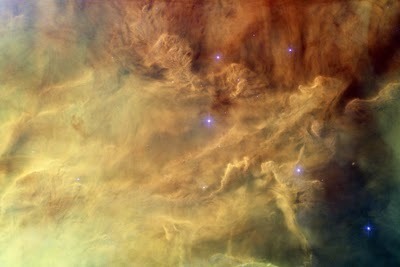
Like brush strokes on a canvas, ridges of color seem to flow across this scene. But here, the canvas is nearly 3 light-years wide and the colors map emission from ionized gas in the Lagoon Nebula, recorded by the Hubble Space Telescope's Advanced Camera for Surveys. Also known as M8, the nebula is a star forming region about 5,000 light-years distant in the constellation Sagittarius. Hubble's remarkably sharp, close-up view reveals undulating shapes sculpted by the energetic light and winds from the region's new born stars. Of course, the Lagoon nebula is a popular target for earthbound skygazers, too. It features a prominent dust lane and bright hourglass shape in small telescopes with wider fields of view.
Photo and commentary courtesy of NASA.
Published on October 02, 2010 05:58
September 30, 2010
Astronomy Photo of Day (Because There is More to Life than Prejudice)
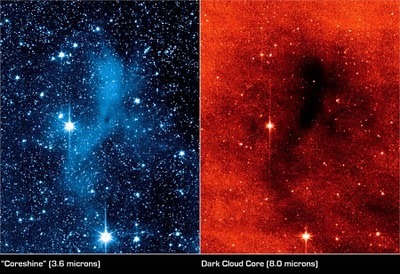
Stars and their planets are born in cold, dark, interstellar clouds of gas and dust. While exploring the clouds at infrared wavelengths, astronomers have made a surprising discovery -- dozens of cases where dense cloud cores shine by reflecting infrared starlight. Based on archival Spitzer Space Telescope data, these panels illustrate the newly described phenomenon, known as coreshine. At longer infrared wavelengths (right) the core of cloud Lynds 183 is dark, but at shorter infrared wavelengths (left) the core clearly shines, scattering light from nearby stars. As seen in these panels, the elongated core covers a mere 1.5 light-years. The scattering requires dust grains that are about 10 times larger than previously thought to exist in the clouds, about 1 micron in size instead of 0.1 micron. For comparison, a human hair is about 100 microns thick. The larger dust grains indicated by coreshine could change models of the early phases of star and planet formation, a still mysterious process hidden within the interstellar clouds. Dark nebula Lynds 183 lies around 325 light-years away in the constellation Serpens.
When I post commentary on the NASA photos, it is by an astronomer and comes from the Astronomy Photo of the Day site. It is not by me. Patrick says I need to make this clear.
Published on September 30, 2010 17:41
Elizabeth Moon and Islam 3
The question then becomes how do we deal with poisonous prejudice. The Wiscon con comm has suggested the following:
Timmi Duchamp has a fine post on Ambling Along the Aqueduct arguing that attempting to have a reasonable discussion about pig-ignorant prejudice reduces us to the simplest level of discourse: Prejudice 101. In doing this, we lose Wiscon's great gift, which is sophisticated discussion and a chance to develop our ideas about beyond the introductory level.
So what do we do? There is direct confrontation, a time honored technique of all the various movements that have helped change America: march, run a picket line, carry signs, shout slogans, sit in, walk out, get in the oppressor's face and mess with his daily activities.
People have suggested walking out of Elizabeth Moon's GoH speech. The trouble is, Nisi Shawl is also a GoH; and she has every right to have to good time at the con, not get mixed into an ugly fight.
And direct confrontation may bring us back to the level of Prejudice 101.
My current plan -- as I told con comm -- is to attend Wiscon and avoid every bit of programming that involves Elizabeth Moon. This is something like the English trade union technique called, 'sending to Coventry,' where workers refuse to acknowledge the existence of any fellow worker who does not support the union.
Because I am not a very confrontational person, and because the thought of being in the same room with Elizabeth Moon makes me feel sick, I figure this may be the best I can manage. It's quiet. It won't damage other people's experience of the con.
The only problem is, I have to figure out how to hear Nisi Shawl's GoH speech, without hearing Elizabeth Moon's. I am still working on that problem.
We know that opinions are not changed by running away from them, but instead by engaging with them, challenging their assumptions, sharing knowledge, seeking understanding, and by lively and candid discourse. And we think that provides a pretty good short description of a typical WisCon.
One might say that WisCon excels at the difficult conversation -- and sometimes the hardest conversation is with an idol who turns out to be human. We have begun addressing our difference of views with Ms. Moon directly, and will continue to do so over the coming months and at the con itself. We hope you will join us in this difficult conversation.
Timmi Duchamp has a fine post on Ambling Along the Aqueduct arguing that attempting to have a reasonable discussion about pig-ignorant prejudice reduces us to the simplest level of discourse: Prejudice 101. In doing this, we lose Wiscon's great gift, which is sophisticated discussion and a chance to develop our ideas about beyond the introductory level.
So what do we do? There is direct confrontation, a time honored technique of all the various movements that have helped change America: march, run a picket line, carry signs, shout slogans, sit in, walk out, get in the oppressor's face and mess with his daily activities.
People have suggested walking out of Elizabeth Moon's GoH speech. The trouble is, Nisi Shawl is also a GoH; and she has every right to have to good time at the con, not get mixed into an ugly fight.
And direct confrontation may bring us back to the level of Prejudice 101.
My current plan -- as I told con comm -- is to attend Wiscon and avoid every bit of programming that involves Elizabeth Moon. This is something like the English trade union technique called, 'sending to Coventry,' where workers refuse to acknowledge the existence of any fellow worker who does not support the union.
Because I am not a very confrontational person, and because the thought of being in the same room with Elizabeth Moon makes me feel sick, I figure this may be the best I can manage. It's quiet. It won't damage other people's experience of the con.
The only problem is, I have to figure out how to hear Nisi Shawl's GoH speech, without hearing Elizabeth Moon's. I am still working on that problem.
Published on September 30, 2010 08:34
Elizabeth Moon and Islam 2
I talk in my previous post about how the history of the US has been the history of accommodating new people and minorities. What I didn't mention is how difficult this often is, and how hostile and violent the majority has often been. Consider slavery and the struggle to end it. You don't get much more violent than the Civil War, at least until the 20th century. Consider the Japanese concentration camps during WWII and the long, painful history of Native Americans since 1492.
This 'negotiation,' as I called it before, often involved murder and sometimes involved war, not only the Civil War, but the Indian Wars.
Which brings me to the famous Frederick Douglass quote:
The problem right now is twofold. The US needed an enemy after the collapse of the Soviet Union to explain by it remains so highly militarized and why Americans cannot have the country they want.
9/11 provided an enemy. Unfortunately the enemy in question was a tiny group of stateless criminals. Hardly a replacement for the Soviet Union. So the enemy had to be expanded. This was done by connecting Al Qaeda to Afghanistan and Iraq. There were Al Qaeda members in Afghanistan at the time, though the plotting for 9/11 was done in Germany and the people involved were mostly Saudi. Strange that the US did not attack Germany or Saudi Arabia... Iraq had no connection at all to Al Qaeda, but it did have lots of oil, and a strategic position in the Middle East. In any case, the enemy was expanded first to Afghanistan and Iraq, then to the entire Islamic world, except American allies such as Pakistan, Saudi Arabia and Turkey.
It is an odd, cobbled-together enemy -- not a state or empire, as the Soviet Union was, but a bunch of varied countries and people who do not necessarily get along. None of these countries has anything close to the military power of the old USSR or anything close to Soviet Union's international reach. Even together, they are not comparable.
So, that is one issue: the need for an enemy. The second issue is demographics in the US: the country is less and less white. It will be majority nonwhite by the middle of this century, and this is making many white Americans crazy.
The current hatred of Muslims is in response to the patchwork enemy, created because the US government needs an enemy, and the changing demographics in the country. There is a lot of political power and emotional fear behind the prejudice, and it is very dangerous. It should be taken seriously.
This 'negotiation,' as I called it before, often involved murder and sometimes involved war, not only the Civil War, but the Indian Wars.
Which brings me to the famous Frederick Douglass quote:
If there is no struggle there is no progress. Those who profess to favor freedom, and yet depreciate agitation, are men who want crops without plowing up the ground. They want rain without thunder and lightning. They want the ocean without the awful roar of its many waters. This struggle may be a moral one; or it may be a physical one; or it may be both moral and physical; but it must be a struggle. Power concedes nothing without demand. It never did and it never will.
The problem right now is twofold. The US needed an enemy after the collapse of the Soviet Union to explain by it remains so highly militarized and why Americans cannot have the country they want.
9/11 provided an enemy. Unfortunately the enemy in question was a tiny group of stateless criminals. Hardly a replacement for the Soviet Union. So the enemy had to be expanded. This was done by connecting Al Qaeda to Afghanistan and Iraq. There were Al Qaeda members in Afghanistan at the time, though the plotting for 9/11 was done in Germany and the people involved were mostly Saudi. Strange that the US did not attack Germany or Saudi Arabia... Iraq had no connection at all to Al Qaeda, but it did have lots of oil, and a strategic position in the Middle East. In any case, the enemy was expanded first to Afghanistan and Iraq, then to the entire Islamic world, except American allies such as Pakistan, Saudi Arabia and Turkey.
It is an odd, cobbled-together enemy -- not a state or empire, as the Soviet Union was, but a bunch of varied countries and people who do not necessarily get along. None of these countries has anything close to the military power of the old USSR or anything close to Soviet Union's international reach. Even together, they are not comparable.
So, that is one issue: the need for an enemy. The second issue is demographics in the US: the country is less and less white. It will be majority nonwhite by the middle of this century, and this is making many white Americans crazy.
The current hatred of Muslims is in response to the patchwork enemy, created because the US government needs an enemy, and the changing demographics in the country. There is a lot of political power and emotional fear behind the prejudice, and it is very dangerous. It should be taken seriously.
Published on September 30, 2010 07:15
September 28, 2010
Elizabeth Moon and Islam
I am going to post here, since my blog is not read by many people, rather than in a more public place. The Wiscon Con Committee and Nisi Shawl are negotiating with Moon at the moment. I don't want to add to the heat and noise. But I do want to think out loud.
(In case you don't know, Moon put a post on her blog saying that Muslims don't make good American citizens, because they refuse to conform to the American mainstream culture. She and Nisi Shawl are guests of honor at Wiscon next year. Since Wiscon takes a strong position against prejudice, this is a problem.)
I have read the Moon essay twice. The first time it gave me an upset stomach and headache that lasted two days. It is poisonous. Given the current mood in the country, it is also dangerous.
What country did this woman grow up in?
The US is full of groups that did not conform to the community at large and who demanded that society accommodate them. The Irish and Germans did not give up their Catholic religion, though English stock Protestants hated it; and they refused to send their kids to the secular public schools. In addition, the Germans opened beer halls and drank publicly and loudly, though it made their Protestant neighbors crazy.
Jews, Hindus and Buddhists have kept their religions and established temples, though this has often freaked out majority Americans.
The Amish dress distinctively, pull their kids out of school after eighth grade and refuse to fight in America's wars.
The Mormons believe in science fiction and live in a theocracy, if the stories I hear about Utah are true. They are also rumored to wear odd underwear.
Native Americans have struggled -- and continued to struggle -- to maintain their native cultures and religions, in spite of the best efforts of white Christian Americans to turn them into white Christians. Black Americans demanded first freedom and then equal rights, though many white Americans were -- and are -- extremely uncomfortable with the idea of free and equal black citizens. Women fought for equal rights and the right to their own independent lives. Gays and lesbians came out of the closet and demanded an end to prejudice against them. Disabled Americans demanded access to education, jobs and public spaces.
The history of the US has been a history of minorities challenging the dominant culture, and the dominant culture changing.
On some issues, the dominate culture remains firm. We do not allow polygamy or genital mutilation, and we are not likely to change our minds about this.
However, in my America, there is a constant negotiation over what American culture is, and a constant expansion of acceptable ways to be American. In this America, Muslims ought to fit in just as well as Jews, Hindus, Buddhists, drunk German Catholics, socialist Finns, out lesbians, and people in wheelchairs who are unwilling to stay at home.
I have wondered for years what American culture is. I guess the answer is, it's subject to change.
(In case you don't know, Moon put a post on her blog saying that Muslims don't make good American citizens, because they refuse to conform to the American mainstream culture. She and Nisi Shawl are guests of honor at Wiscon next year. Since Wiscon takes a strong position against prejudice, this is a problem.)
I have read the Moon essay twice. The first time it gave me an upset stomach and headache that lasted two days. It is poisonous. Given the current mood in the country, it is also dangerous.
What country did this woman grow up in?
The US is full of groups that did not conform to the community at large and who demanded that society accommodate them. The Irish and Germans did not give up their Catholic religion, though English stock Protestants hated it; and they refused to send their kids to the secular public schools. In addition, the Germans opened beer halls and drank publicly and loudly, though it made their Protestant neighbors crazy.
Jews, Hindus and Buddhists have kept their religions and established temples, though this has often freaked out majority Americans.
The Amish dress distinctively, pull their kids out of school after eighth grade and refuse to fight in America's wars.
The Mormons believe in science fiction and live in a theocracy, if the stories I hear about Utah are true. They are also rumored to wear odd underwear.
Native Americans have struggled -- and continued to struggle -- to maintain their native cultures and religions, in spite of the best efforts of white Christian Americans to turn them into white Christians. Black Americans demanded first freedom and then equal rights, though many white Americans were -- and are -- extremely uncomfortable with the idea of free and equal black citizens. Women fought for equal rights and the right to their own independent lives. Gays and lesbians came out of the closet and demanded an end to prejudice against them. Disabled Americans demanded access to education, jobs and public spaces.
The history of the US has been a history of minorities challenging the dominant culture, and the dominant culture changing.
On some issues, the dominate culture remains firm. We do not allow polygamy or genital mutilation, and we are not likely to change our minds about this.
However, in my America, there is a constant negotiation over what American culture is, and a constant expansion of acceptable ways to be American. In this America, Muslims ought to fit in just as well as Jews, Hindus, Buddhists, drunk German Catholics, socialist Finns, out lesbians, and people in wheelchairs who are unwilling to stay at home.
I have wondered for years what American culture is. I guess the answer is, it's subject to change.
Published on September 28, 2010 06:38
Sioux Falls
Patrick and I drove to Sioux Falls this past weekend to attend the Northern Plains Indian Art Market. The market was disappointing: far smaller than it used to be. However, most of the artists I like were still there. They are all people from the Dakotas. The Blackfoot from farther west, who do awesome beadwork, were not there. Nor were the plains Ojibwa, who are also fine beadworkers.
Patrick bought a ring from Paul Szabo, a Lakota silversmith from the Rosebud Reservation. I got a pair of earrings that Szabo made: highly stylized, geometric spiders. The Lakota trickster is Iktomi the Spider, though I don't know if my spiders are Iktomi.
There has been heavy rain and flooding through the Upper Midwest. Driving back, we dcided to take two lane highways rather than the Interstate. We ran into a detour on the Highway 14, which was probably flooding along the Cottonwood River. But it didn't take us far out of way; and the drive was pleasant, through golden fields under a bright blue sky.
We got some terrific photos in Sioux Falls of the falls on the Big Sioux River, which is running very high.
I wrote a poem:

Patrick bought a ring from Paul Szabo, a Lakota silversmith from the Rosebud Reservation. I got a pair of earrings that Szabo made: highly stylized, geometric spiders. The Lakota trickster is Iktomi the Spider, though I don't know if my spiders are Iktomi.
There has been heavy rain and flooding through the Upper Midwest. Driving back, we dcided to take two lane highways rather than the Interstate. We ran into a detour on the Highway 14, which was probably flooding along the Cottonwood River. But it didn't take us far out of way; and the drive was pleasant, through golden fields under a bright blue sky.
We got some terrific photos in Sioux Falls of the falls on the Big Sioux River, which is running very high.
I wrote a poem:
We are photographing the Big Sioux River,
twice as big as it's supposed to be,
flooding houses and garages,
cars half under water;
a guy says where he's from in Iowa
flood water took out a dam a week ago.
"It isn't supposed to be like this,
not in September."
We don't mention global warming.
Instead, we drive down to Sioux Falls
to photograph water crashing and foaming
over ledges of pink sioux quartzite,
people walking on the stone at the river's edge,
watching and taking pictures,
mostly quiet and serious,
as if this is somehow important.
Published on September 28, 2010 06:24
September 27, 2010
Astronomy Photo of the Day from NASA
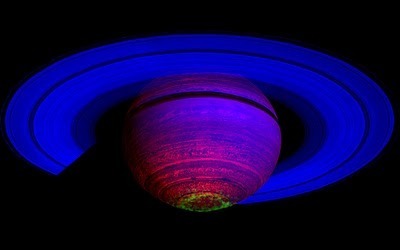
What drives auroras on Saturn? To help find out, scientists have sorted through hundreds of infrared images of Saturn taken by the Cassini spacecraft for other purposes, trying to find enough aurora images to correlate changes and make movies. Once made, some movies clearly show that Saturnian auroras can change not only with the angle of the Sun, but also as the planet rotates. Furthermore, some auroral changes appear related to waves in Saturn's magnetosphere likely caused by Saturn's...
Published on September 27, 2010 06:32
September 26, 2010
Astronomy Photo of the Day from NASA
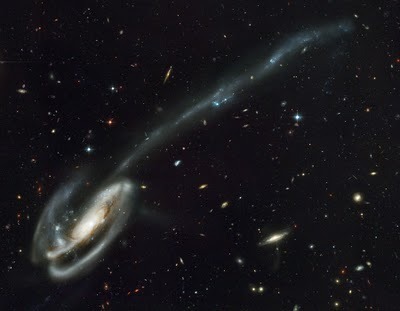
Why does this galaxy have such a long tail? In this stunning vista recorded with the Hubble Space Telescope's Advanced Camera for Surveys, distant galaxies form a dramatic backdrop for disrupted spiral galaxy Arp 188, the Tadpole Galaxy. The cosmic tadpole is a mere 420 million light-years distant toward the northern constellation Draco. Its eye-catching tail is about 280 thousand light-years long and features massive, bright blue star clusters. One story goes that a more compact intruder...
Published on September 26, 2010 17:18
September 23, 2010
Astronomy Photo of the Day
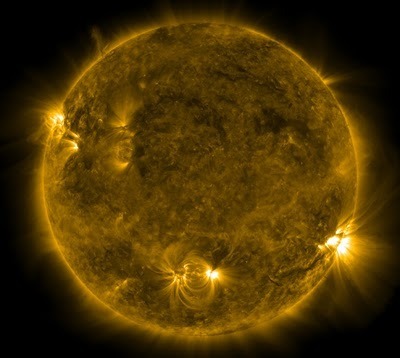
Today, the Sun crosses the celestial equator heading south at 03:09 Universal Time. Known as an equinox, this astronomical event marks the first day of autumn in the northern hemisphere and spring in the south. Equinox means equal night. With the Sun on the celestial equator, Earth dwellers will experience nearly 12 hours of daylight and 12 hours of darkness. Of course, in the north the days continue to grow shorter, the Sun marching lower in the sky as winter approaches. To celebrate the...
Published on September 23, 2010 12:23
Eleanor Arnason's Blog
- Eleanor Arnason's profile
- 73 followers
Eleanor Arnason isn't a Goodreads Author
(yet),
but they
do have a blog,
so here are some recent posts imported from
their feed.



